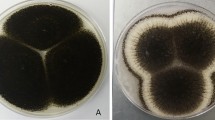Abstract
Black peppercorns supported the growth of Aspergillus parasiticus (flavus) NRRL 3145. Incubation at 28 C and RH of 85% for 30 days resulted in profuse conidial production on the reticulate ridges of the peppercorns. An SEM study of these ridges showed that they were cortical eruptions, and the particulate matter present favored mycelial establishment. Hyphal anastamoses were commonly observed. Following this incubation the inoculated peppercorns were stored in the dark at room temperature and ambient humidity for 15 days. Aflatoxin was detected on a minicolumn. Aflatoxin B1 was produced at levels of 60 μg/kg with traces of aflatoxins B 2, G1 and G2. Quantitative estimation was based on a visual comparison with standards by thin-layer chromatography.
Similar content being viewed by others
References
Christensen, C.M., H.A. Fanse, G.H. Nelson, F. Bates & C.J. Mirocha. 1967. Microflora of black and red pepper. Appl. Microbiol. 15: 622–626.
Christensen, C.M. 1975. Molds, Mushrooms & Mycotoxins. University of Minnesota Press, Minneapolis.
Flannigan, B. & S.C. Hui. 1976. The occurrence of aflatoxin-producing strains of Aspergillus flavus in the mould floras of ground spices. J. Appl. Bacteriol. 41: 411–418.
Hitokota, H., S. Morozumi, T. Wauke, S. Sakai & H. Kurata. 1977. Mycotoxin production of fungi on commercial foods. Mycotoxins in human and animal health. pp. 479–487. Pathotox Pub. Inc., Illinois.
Hitokoto, H., S. Morozumi, T. Wauke, S. Sakai & I. Ueno. 1978. Inhibitory effects of condiments and herbal drugs on the growth and toxin production of toxigenic fungi. Mycopathologia. 66: 161–167.
Holaday, C.E. & J. Lansden. 1975. Rapid screening method for aflatoxin in a number of products. J. Agric. Food Chem. 23: 1134–1136.
Pal. N. & A.K. Kundu. 1972. Studies on Aspergillus spp from Indian spices in relation to aflatoxin production. Science and Culture. 38: 252–254.
Schroeder, H.W. 1973. Accumulation of only aflatoxin B2 by a strain of Aspergillus flavus. Appl. Microbiol. 25: 146–148.
Scott, P.M. & B.P.C. Kennedy. 1973. Analysis and survey of ground black, white and capsicum peppers for aflatoxins. J. Assoc. Offic. Anal. Chem. 56: 1452–1457.
Seenappa, M. & A.G. Kempton. 1979. Application of a minicolumn detection method for screening spices for aflatoxin. (unpublished).
Seenappa, M., L.W. Stobbs & A.G. Kempton. 1979. Colonization of red pepper by Aspergillus. Phytopathology. (in press).
Suzuki, J.I., B. Dainus & J.H. Kilbuck. 1973. A modified method for aflatoxin determination in spices. J. Food Sci. 38: 949–950.
Author information
Authors and Affiliations
Rights and permissions
About this article
Cite this article
Seenappa, M., Kempton, A.G. Aspergillus growth and aflatoxin production on black pepper. Mycopathologia 70, 135–137 (1980). https://doi.org/10.1007/BF00443023
Issue Date:
DOI: https://doi.org/10.1007/BF00443023




